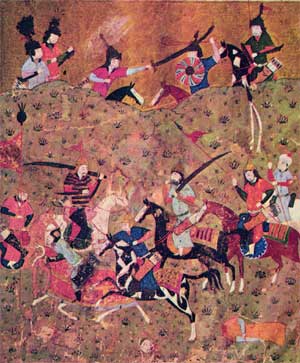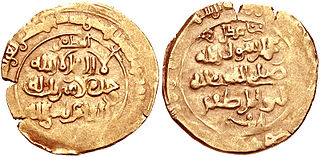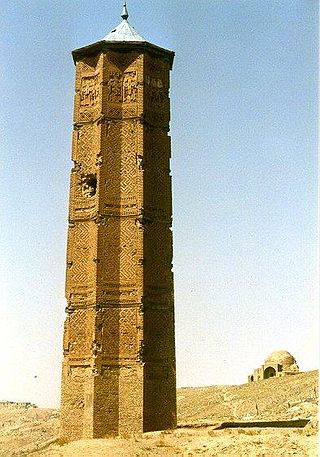Related Research Articles

The Saffarid dynasty was a Persianate dynasty of eastern Iranian origin that ruled over parts of Persia, Greater Khorasan, and eastern Makran from 861 to 1002. One of the first indigenous Persian dynasties to emerge after the Islamic conquest, the Saffarid dynasty was part of the Iranian Intermezzo. The dynasty's founder was Ya'qub bin Laith as-Saffar, who was born in 840 in a small town called Karnin (Qarnin), which was located east of Zaranj and west of Bost, in what is now Afghanistan. A native of Sistan and a local ayyār, Ya'qub worked as a coppersmith (ṣaffār) before becoming a warlord. He seized control of the Sistan region and began conquering most of Iran and Afghanistan, as well as parts of Pakistan, Tajikistan and Uzbekistan.

The Ghaznavid dynasty or the Ghaznavid Empire was a Persianate Muslim dynasty and empire of Turkic mamluk origin, ruling at its greatest extent, large parts of Iran, Khorasan, and the northwest Indian subcontinent from 977 to 1186. The dynasty was founded by Sabuktigin upon his succession to the rule of Ghazna after the death of his father-in-law, Alp Tigin, who was an ex-general of the Samanid Empire from Balkh.

Abu Talib Muhammad Tughril ibn Mika'il, better known as Tughril, was a Turkoman chieftain, who founded the Seljuk Empire, ruling from 1037 to 1063.

The Anushtegin dynasty or Anushteginids, also known as the Khwarazmian dynasty was a Persianate Sunni Muslim dynasty of Turkic mamluk origin from the Bekdili clan of the Oghuz Turks. The Anushteginid dynasty ruled the Khwarazmian Empire, consisting in large parts of present-day Central Asia, Afghanistan and Iran in the approximate period of 1077 to 1231, first as vassals of the Seljuks and the Qara Khitai, and later as independent rulers, up until the Mongol conquest of the Khwarazmian Empire in the 13th century.

Ahmad Sanjar was the Seljuq ruler of Khorasan from 1097 until 1118, when he became the Sultan of the Seljuq Empire, which he ruled until his death in 1157.

Muhammad I Tapar, was the sultan of the Seljuk Empire from 1105 to 1118. He was a son of Malik-Shah I and Taj al-Din Khatun Safariya.
The Ghurid dynasty was a Persianate dynasty of presumably eastern Iranian Tajik origin, which ruled from the 8th-century in the region of Ghor, and became an Empire from 1175 to 1215. The Ghurids were centered in the hills of the Ghor region in the present-day central Afghanistan, where they initially started out as local chiefs. They gradually converted to Sunni Islam after the conquest of Ghor by the Ghaznavid ruler Mahmud of Ghazni in 1011. The Ghurids eventually overran the Ghaznavids when Muhammad of Ghor seized Lahore and expelled the Ghaznavids from their last stronghold.

The Battle of Dandanaqan was fought in 1040 between the Seljuq Turkmens and the Ghaznavid Empire near the city of Merv. The battle ended with a decisive Seljuq victory, which subsequently brought down the Ghaznavid domination in Greater Khorasan.

Falak al-Ma'ali Manuchihr, better known as Manuchihr, was the ruler of the Ziyarids. He was the son of Qabus.

Shahāb-ud-Dawla Mawdūd, known as Mawdud of Ghazni, was a sultan of the Ghaznavids from 1041 – 1050. He seized the throne of the sultanate from his uncle, Muhammad of Ghazni, in revenge for the murder of his father, Mas'ud I of Ghazni. His brother Majdud in Lahore did not recognize him as sultan, but his sudden death paved the way for Mawdud to exercise control over the eastern portion of the Ghaznavid Empire.

The Seljuk dynasty, or Seljukids, Seljuqs, also known as Seljuk Turks, Seljuk Turkomans or the Saljuqids, was an Oghuz Turkic, Sunni Muslim dynasty that gradually became Persianate and contributed to Turco-Persian culture in West Asia and Central Asia. The Seljuks established the Seljuk Empire (1037–1194), the Sultanate of Kermân (1041–1186) and the Sultanate of Rum (1074–1308), which stretched from Iran to Anatolia and were the prime targets of the First Crusade.
Altuntash was a Turkic Khwarazmshah from 1017 until his death in 1032.

Abu Suleiman Dawud Chaghri Beg ibn Mikail, widely known simply as Chaghri Beg (989–1060), Da'ud b. Mika'il b. Saljuq, also spelled Chaghri, was the co-ruler of the early Seljuk Empire. The name Chaghri is Turkic and literally means "small falcon", "merlin".

Farrukh-Zad, was sultan of the Ghaznavid Empire from. His reign was considered one of benevolence, prosperity and tranquility for the Ghaznavid empire. It was free of the chaotic turbulence and greed from palace ghulams until the end of his reign. He was a very devout Muslim and fasted during Rajab, Sha'ban and Ramadan.

Ibrahim of Ghazna was sultan of the Ghaznavid empire from April 1059 until his death in 1099. Having been imprisoned at the fortress of Barghund, he was one of the Ghaznavid princes that escaped the usurper Toghrul's massacre in 1052. After his brother Farrukh-Zad took power, Ibrahim was sent to the fortress of Nay, the same fortress where the poet Masud Sa'd Salman would later be imprisoned for ten years.
Abu'l-Muzaffar Khusrau Malik ibn Khusrau-Shah, better known simply as Khusrau Malik, was the last Sultan of the Ghaznavid Empire, ruling from 1160 to 1186. He was the son and successor of Khusrau Shah.

Ghazni is a city in southeastern Afghanistan, which served as the capital of the Ghaznavid Empire from 977 to 1163.
Fakhr al-Mulk was a Persian bureaucrat, who served as the vizier of the Seljuk sultan Berkyaruq from 1095 to 1099, and later vizier of the Sejluk prince and ruler of Khurasan, Ahmad Sanjar, from 1101 to 1106. He was the eldest son of the prominent Seljuk vizier Nizam al-Mulk.
References
- ↑ Rickmers 1899, p. 101.
- ↑ Sen 1988, p. 342.
- ↑ Bosworth 1998, p. 98.
- ↑ Bosworth 1963, p. 45.
- ↑ Sicker 2000, p. 48.
- 1 2 Chandra 2006, p. 18.
- ↑ Bosworth 1977, p. 31.
- ↑ Brockelmann, Perlmann & Carmichael 1947, p. 169.
- ↑ Grousset 2002, p. 146.
- ↑ Ali 2011, p. 543.
- ↑ Bosworth 1994, p. 207.
- ↑ Bosworth 1968, p. 19.
- 1 2 Bosworth 1999, p. 188.
- ↑ Ibn al-Athir 2002, p. 35.
- ↑ Sen 1988, p. 357.
- ↑ Safi 2006, p. 24.
- ↑ Blair 1992, p. 112.
- ↑ Grousset 2002, p. 147.
- ↑ Bosworth 1977, p. 28.
- ↑ Bosworth 1977, p. 22-24.
- ↑ Bosworth 1977, p. 26.
- ↑ Bosworth 1977, p. 29.
- ↑ Bosworth 1977, p. 43.
- ↑ Bosworth 1977, p. 44.
- ↑ Helms 1983, p. 342-354.
- ↑ Bosworth 1977, p. 93.
- 1 2 Bosworth 1977, p. 96.
- ↑ Bosworth 1977, p. 114-115.
- ↑ Bosworth 1977, p. 126.
- ↑ Bosworth 2012.